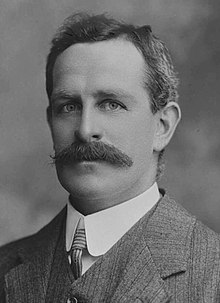Frank Tudor
|
The Honourable Frank Tudor |
|
|---|---|
 |
|
|
Leader of the Opposition Elections: 1917, 1919 |
|
|
In office 14 November 1916 – 10 January 1922 |
|
| Prime Minister | Billy Hughes |
| Deputy | Albert Gardiner |
| Preceded by | Joseph Cook |
| Succeeded by | Matthew Charlton |
| Leader of the Labor Party | |
|
In office 14 November 1916 – 10 January 1922 |
|
| Deputy | Albert Gardiner |
| Preceded by | Billy Hughes |
| Succeeded by | Matthew Charlton |
| Member of the Australian Parliament for Yarra | |
|
In office 30 March 1901 – 10 January 1922 |
|
| Preceded by | Seat created |
| Succeeded by | James Scullin |
| Personal details | |
| Born |
27 January 1866 Williamstown, Victoria |
| Died | 10 January 1922 (age 55) Richmond, Victoria |
| Nationality | Australian |
| Political party | Australian Labor Party |
| Spouse(s) | Fanny Jane Mead |
Francis Gwynne "Frank" Tudor (29 January 1866 – 10 January 1922) was an Australian-born felt hatter and politician. He was the leader of the Australian Labor Party from 1916 until his death.
Tudor was born to John Llewellyn Tudor, a ballastman, and Ellen Charlotte Tudor, née Burt, both of Welsh origin, on 29 January 1866 at Williamstown, Victoria. However, the family soon moved to the Melbourne suburb of Richmond, where Tudor lived most of his life.
Upon leaving Richmond Central State School, and after short spells in a sawmill and a boot factory, Tudor entered the felt hat industry. Tudor apprenticed in Abbotsford and then travelled across Victoria in the hat trade. Tudor went to England, working in London, Birmingham, Liverpool and Manchester, marrying Alice Smale in Denton, Lancashire in 1894. Smale died the same year, but Tudor continued in the felt hat trade by moving to London and becoming vice-president of the local branch of the Felt Hatters' Union. In 1897 Tudor remarried to Fanny Jane Mead.
As vice-president of the union Tudor became interested in union politics (as many Labor politicians were before their entry into politics) and persuaded the British unions to adopt the union label principle. Returning to Australia, Tudor worked at Abbotsford's mills and took a seat in the Victorian Trades Hall Council. In 1900 he became president.
A prominent figure in Richmond, Victoria, Tudor turned the Division of Yarra into the safest Labor seat in the country by winning that seat by a large margin in the 1901 federal election. Tudor was a deacon of the Congregational Church and angered some Protestants with his calls for Home Rule for Ireland.
...
Wikipedia
